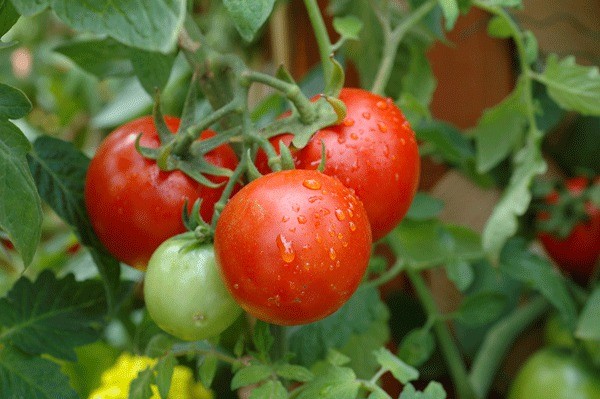If you grew up in an area where summer days were hot and humid and the nights were only slightly cooler, you’ve probably enjoyed what seemed like an endless crop of luscious tomatoes.
In the more moderate climate of the North Olympic Peninsula, growing tomatoes typically is easier than ripening them to their sweet, juicy maturity. Vine-ripened home-grown tomatoes are hard to come by. However, it can be done and here’s how.
First step
Select tomato varieties adapted to our short growing season. (See sidebar) Cherry-sized tomatoes ripen faster than full-sized tomatoes. Varieties suited to cooler environments ripen earlier than varieties developed for warmer climates.
Site selection
Plants require at least six hours of sunlight each day. An ideal location is in full sun, on the south side of a building where plants will benefit from both direct and reflected light and heat.
All tomatoes need deep, loose soil that is high in organic material with a pH of 5.5 to 7.0. Soil that is high in organic material has better drainage and warms faster than dense, clay-like soil.
Do a soil test and prepare your soil before planting because good soil will hasten plant growth and maturity, and improve yield.
Tomato plants also need good air circulation to prevent mildew, but should be protected from too much wind that will reduce the temperature around the plants.
If you don’t have a planting site with these characteristics, consider planting your tomatoes in a raised bed to improve drainage and increase soil temperature, in containers that can be moved to “follow the sun,” or in a hoop-house to protect the plant from cool nights and coastal fog.
Planting
Most local gardeners use tomato starts to get a jump on the season. Transplant seedlings when the soil temperature is a minimum of 55 degrees. (60 degrees is even better!) For many gardens on the North Olympic Peninsula, this is early June. Planting too early will delay growth and the production and ripening of fruit.
To plant, remove the tomato plant from its container and separate its roots if they are encircling.
Trim off all except the top three or four branches/leaves. Dig a hole deep enough to bury the roots and the lower portion of the main stem (where you have removed the leaves). Before planting, fill the hole with water and let it be absorbed; then add slow-release fertilizer that is low in nitrogen (5-10-10) to the bottom of the hole, covering the fertilizer with two inches of soil to protect plant roots. Set the plant upright in the hole and fill with native dirt. Roots will grow along the buried stem.
Provide vertical support by using a cage or staking the plant. Supported plants benefit from improved air circulation, fruit elevation above moist soil and less damage from snails and slugs.
Mulch the soil around the plant to maintain soil temperature and moisture. Give each plant one to two gallons of water weekly. Fertilize tomatoes again two months after planting with a 5-10-10 fertilizer. Additional fertilizing later in the growing season is not normally recommended, as it can result in overly abundant foliage at the expense of fruit production.
With a little effort, you, too, can grow the big juicy luscious tomatoes of your childhood.
Pearl of Wisdom
Use trench planting to improve tomato production in cooler climates. Dig a trench six to eight inches deep and as long as the height of your tomato plant. Remove all but the top three or four leaves and lay the plant horizontally in the trench. Bury the main stem and roots, while gently bending the plant so the remaining leaves are above ground. The proximity to the surface keeps the roots warmer, increasing plant growth.
For more
For free gardening help, visit a local Master Gardener plant clinic. Clinics are held Saturdays at the Demonstration Garden on 2711 Woodcock Road in Sequim from
9 a.m.-1 p.m. and Mondays at the Clallam County Courthouse, 223 E. Fourth St., in Port Angeles from 9 a.m.-
1 p.m. Bring gardening questions, samples from problem plants and garden pests.
Judy English is a WSU-certified Clallam County Master Gardener.
Recommended tomato varieties
Local nurseries usually carry tomato varieties that produce well in the local area.
Among the many varieties recommended on the North Olympic Peninsula are:
• Sun Gold (cherry-sized),
• Early Girl (indeterminate),
• Big Beef (indeterminate),
• Ispolin (indeterminate),
• Stupice (indeterminate),
• Beaverlodge Slicer (determinate), and
• Oregon Spring (determinate).
Note: “Indeterminate” tomatoes produce fruit throughout the season; “determinate” tomatoes produce the bulk of their fruit over a two- to three-week period and set minimal amounts of fruit thereafter.
Recipe: Tomato Salsa
Tomatoes are a great source of vitamin C, potassium, folate and vitamin K and a major source of the antioxidant lycopene which has been linked to a reduced risk of heart disease and cancer. Try this salsa recipe for a tasty tomato treat year-round.
Ingredients
30 cups tomatoes, washed, peeled, chopped and drained
4 cups onions, washed, peeled and chopped
3 jalapeño peppers, washed, chopped with seeds
3 mild peppers, washed and chopped
3 Tbsp. chopped garlic
6 oz. rice wine vinegar (4.3 percent acidity)
¼ cup pickling salt
1 Tbsp. fresh ground pepper
2 Tbsp. ground cumin
1½ Tbsp. chili pepper
18 oz. tomato paste
¼ cup sugar
Mix all ingredients. Simmer until appropriate thickness, as rapidly as possible, stirring often. Can pints in a 20-minute water bath. Makes about 8 pints.


